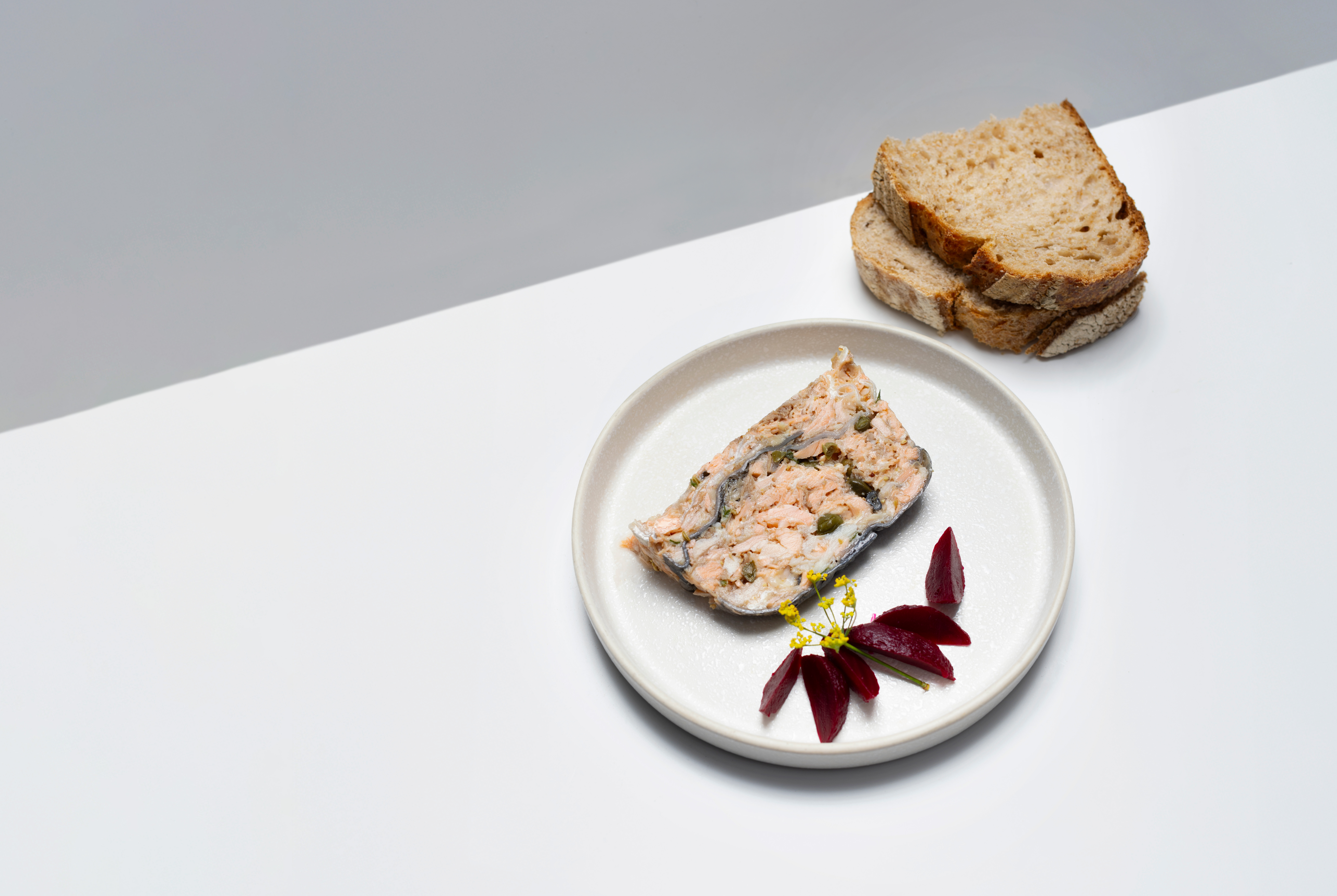Salmon Head Terrine With Tarragon
When it comes to salmon, the consumer demand exclusively asks for the prime cut, leaving enormous heaps of waste such as heads, tails and bones. We propose using these parts, and developing a recipe close to the Dutch traditional food called Kopkaas, loosely translated to head-cheese, formally called a brawn. Here the final dish becomes something that resembles an artisanal pate. The preparation calls for head, tails and spines, urging those who wish to cook it to explore alternative supply chains, resulting, quite literally, in a face to face meeting in the kitchen with an animal they eat often, but rarely encounter. We serve this dish with sourdough bread and pickled beetroots.

approximately 1.5 - 1.8 kg, about 15 slices
Ingredients
10 large salmon heads (approximately 1.5 kg of meat after cooking)
1 shallot, finely sliced
150g small salted capers, rinsed
85g mustard (Whole grain works best)
Zest of 1 lemon
A handful of tarragon leaves (If preferred, this can be substituted by dill, parsley, or foraged horseweed)
Cracked white pepper, to taste
Cracked fennel seeds, to taste
Salt, to taste
Gelatin 2 sheets
To Serve
Sourdough bread
Pickled beets (We used products from the Oos Kesbeke & Jonnie de Boer collab)
Instructions
1. Prepare the Salmon Head Meat
Begin by cooking the salmon heads until the meat is tender and easy to separate from the bones (you can simmer them in a steam oven for 20 mins under 60 degrees and also be done using water steaming). Once cooked, remove the meat from the heads very carefully, discard any bones, skin, and small gills, and roughly shred the flesh. Let the meat cool slightly but keep it warm for mixing.
2. Prepare the Gelatin
Soak 2 sheets of gelatin in cold water for 5 minutes. This will soften the gelatin and allow it to dissolve easily.
After 5 minutes, remove the gelatin from the cold water and add it to 100ml of hot water (but not boiling). Stir well to dissolve the gelatin completely.
3. Combine the Ingredients
In a large mixing bowl, add the warm salmon head meat.
Stir in the finely sliced shallot, rinsed capers, mustard, and lemon zest.
Finely chop the fresh herbs and add them to the mixture.
Pour in the gelatin solution (the dissolved gelatin and hot water) and stir it into the salmon mixture. This will help the terrine set as it cools, ensuring the mixture holds together once pressed.
Season with cracked white pepper, fennel seeds, and salt to taste. Mix everything together until well combined. The warmth of the salmon meat should help the mustard, herbs, and seasonings incorporate smoothly.
4. Prepare the Terrine Mould
Line the mould with a layer of plastic wrap oversized.
Carefully spoon the salmon mixture into the mould, pressing it down firmly as you go to ensure there are no air pockets. The mixture should fill the mould completely.
5. Press the Terrine
Once the mixture is packed into the mould, fold the overhanging plastic wrap over the top to cover it.
Place a piece of thick cardboard (cut to the size of the terrine) over the top of the mixture to help it retain its shape and provide even pressure.
Weigh the terrine down with a heavy object (such as a can, a small pot, or a weight) to ensure the terrine sets firmly.
6. Refrigerate
Allow the terrine to set in the refrigerator overnight, or for at least 6-8 hours. This will help the flavors meld together and the texture to firm up.
Serve
After the terrine has set, remove it from the fridge and unwrap the plastic. Use a sharp kitchen knife to slice it into neat portions. Store the terrine in the refrigerator, keeping it wrapped to prevent it from drying out.
